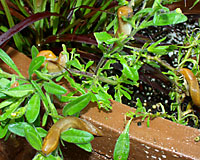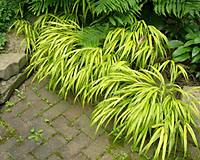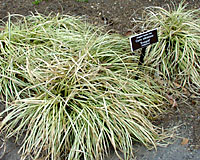Terry L. Ettinger Horticulture Consulting Services
Meeting The Needs Of Today With A Vision For The Future
Question of the Week
Slugs and Snails in the Garden
 Q. I planted six different kinds of hosta in a shady, sometimes damp corner of my property two years ago.
The really big, green-leafed types have done really well, but the
smaller variegated types always seem to be filled with large holes. My neighbor says
that slugs are the culprit and says that I should sprinkle mothballs under the plants. Should I heed her advice?
Q. I planted six different kinds of hosta in a shady, sometimes damp corner of my property two years ago.
The really big, green-leafed types have done really well, but the
smaller variegated types always seem to be filled with large holes. My neighbor says
that slugs are the culprit and says that I should sprinkle mothballs under the plants. Should I heed her advice?
A. Your neighbor is probably right about the slugs - the leaves of many hosta are an absolute delicacy to these slimy critters! However, I’m not so quick to agree with her recommendation of mothballs as a slug deterrent as there are several non-chemical methods of addressing this common problem.
 Since slugs thrive in moist, shaded environments - exactly the type of site in which hosta are often planted - my first
recommendation would be to move your variegated hosta to a slightly drier part of your landscape. As replacements for
those plants consider variegated Hakonechloa or Japanese Hakone Grass (Hakonechloa macra ‘Aureola’),
at left,
‘Golden Variegated’ Japanese sweet flag (Acorus gramineus ‘Ogon’), variegated lilyturf (Liriope muscari),
or `Evergold’ Japanese sedge (Carex oshimensis 'Evergold'),
at right, below.
Since slugs thrive in moist, shaded environments - exactly the type of site in which hosta are often planted - my first
recommendation would be to move your variegated hosta to a slightly drier part of your landscape. As replacements for
those plants consider variegated Hakonechloa or Japanese Hakone Grass (Hakonechloa macra ‘Aureola’),
at left,
‘Golden Variegated’ Japanese sweet flag (Acorus gramineus ‘Ogon’), variegated lilyturf (Liriope muscari),
or `Evergold’ Japanese sedge (Carex oshimensis 'Evergold'),
at right, below.
 If you really want to keep hosta in this part of your garden, consider replacing the variegated varieties with more
slug-resistant varieties. It’s often suggested, for example, that blue-leafed hosta varieties, hosta with thick, crinkled
leaves, and varieties that become quite large over the coarse of a growing season are less susceptible to slug damage.
If you really want to keep hosta in this part of your garden, consider replacing the variegated varieties with more
slug-resistant varieties. It’s often suggested, for example, that blue-leafed hosta varieties, hosta with thick, crinkled
leaves, and varieties that become quite large over the coarse of a growing season are less susceptible to slug damage.
You also can use various types of homemade “traps” to reduce the number of slugs among your hosta.
Pieces of wood, cardboard or melon rinds laid flat on the ground among your plants will provide a cool, moist shelter for slugs. In mid- to late afternoon, simply pick the traps up and scrape the slugs you find clinging to them into a bucket of water containing a little ammonia. Once the slugs are dead, pour the solution into your compost pile where the small amount of nitrogen in the ammonia will help speed the decomposition process of woody materials.
You also can make traps out of empty coffee cans by carefully cutting several one inch-diameter holes half way up the sides of the cans with tin snips. Pour an inch or two of water/ammonia solution into the cans, replace the lids and bury them in the ground between the hosta up to the lower edge of the holes on the sides of the cans. During the heat of the day slugs will crawl through holes, drop into the water/ammonia solution and drown. Every couple of days pour the dead slugs into the compost pile, rinse the can, add more water and ammonia, put the lids back on and reset the cans among your plants.
To be effective, traps should be placed about three feet apart throughout your hosta planting. And, patience is definitely a virtue as there may be times where you’ll go several days without catching any slugs!